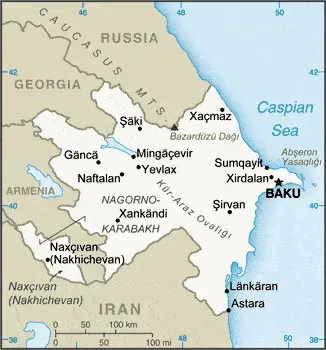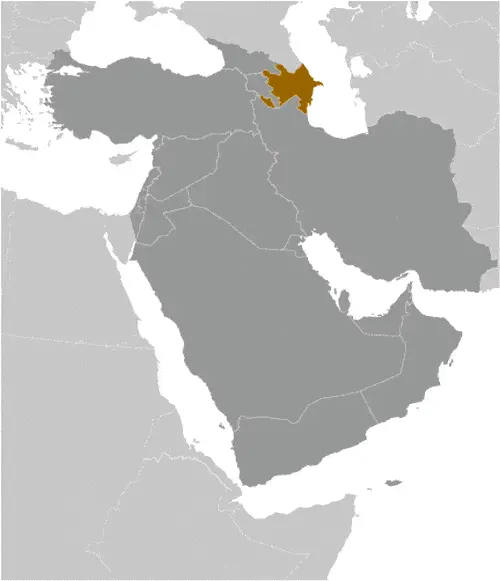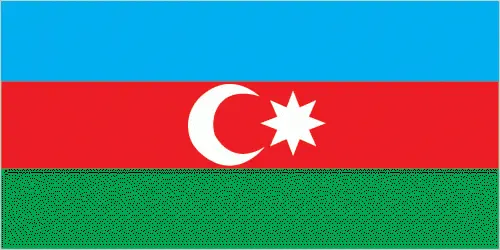Google Maps and detailed facts of Azerbaijan (AZ). This page lets you explore Azerbaijan and its border countries (Country Location: Southwestern Asia, bordering the Caspian Sea, between Iran and Russia, with a small European portion north of the Caucasus range) through detailed Satellite imagery – fast and easy as never before Google Maps.
Find comprehensive information about this country’s diversity below: Google maps, geography, economy, science, people, culture, environment, government, and history – All in One Wiki page.
There is also a Street View and free Driving Directions at your service. Your Google Satellite Map Sightseeing in Azerbaijan, in Asia, starts here at Driving Directions and Maps.com.
About Azerbaijan in detail
Table of contents
- Background
- Overview
- Google Maps
- Climate
- Geography
- Resources and Land Use
- Population Data
- Economic Data
- Drinking Water Source
- Population, Median Age, Migration, and Citizenship
- Average Number of Childbirths
- Is this country a Safe Destination?
- Healthcare and Infectious Diseases
- Natural Hazards
- The Flag and Other Symbols
- Constitution
- Legal System
- About the Unemployment Rate, Labor Force, and Poverty Line
- About the Budget and Central Government Debt
- Inflation Rate and Prime Lending Rate
- Export/Import Partners and Data
- Renewable Energies Used
- Telecommunication Data, Calling Code
- Transport Infrastructure
- More Interesting Facts
Background
Azerbaijan, a nation with a rich tapestry of history and culture, is nestled at the crossroads of Eastern Europe and Western Asia. Historically, it has been a crucial juncture for various civilizations due to its strategic location. Today, Azerbaijan blends its ancient heritage with modern aspirations, fostering a unique identity that resonates through its cities and countryside.
Overview
Renowned for its diverse landscapes and cultural richness, Azerbaijan is a fascinating blend of old and new. The country boasts a vibrant economy primarily driven by its abundant natural resources, particularly oil and gas. Its capital, Baku, symbolizes this blend, showcasing impressive modern architecture alongside historic sites.
Official Name: Republic of Azerbaijan
Date of Formation: Declared independence from the Soviet Union on August 30, 1991; adopted by the Supreme Council of Azerbaijan on October 18, 1991.
Capital: Baku (Baki, Baky).
Population: 10,420,515 (2023 estimate)
Total Area: 86,600 sq km
Population Density: N/A
Languages: Azerbaijani (Azeri) (official) 92.5%, Russian 1.4%, Armenian 1.4%, other 4.7% (2009 est.).
Religions: Muslim 97.3% (predominantly Shia), Christian 2.6%, other <0.1, unaffiliated <0.1 (2020 est.).
Ethnic Origin: Over 80 ethnic groups in the Nagorno-Karabakh region, populated almost entirely by ethnic Armenians.
Government: Presidential republic.
Currency: Azerbaijani manats (AZN).
Literacy Rate: 99.8%
Calorie Consumption: N/A
Azerbaijan Google Maps
Google Maps provides an invaluable tool for exploring Azerbaijan’s varied topography and urban developments. From Baku’s bustling streets to the Caucasus Mountains’ serene landscapes, Google Maps offers detailed insights and navigational support, enhancing the experience of both tourists and residents.
Situated on the western coast of the Caspian Sea, it was the first Soviet republic to declare independence in 1991. Territorial disputes with Armenia have dominated politics since. The Caucasus Mountains are in the west, including the Naxçivan exclave south of Armenia. Flat, low-lying terrain on the coast of the Caspian Sea.
The map below shows Azerbaijan’s cities, towns, highways, main roads, streets, and Street Views. To find a location, use the form below, type any city or place, view a simple map, and click the “show map” button.
The Google Map above shows Azerbaijan’s location: Asia (geographic coordinates: 40 30 N, 47 30 E) and the international borders of Azerbaijan; total: 2,468 km. Border countries (total: 5): Armenia 996 km, Georgia 428 km, Iran 689 km, Russia 338 km, Turkey 17 km; furthermore, it’s inland counties boundaries.
The map of Azerbaijan, Asia, is for informational use only. No representation is made or warrantied given any map or its content by Driving Directions and Maps site. The user assumes all risks of using this Azerbaijan Google map and facts/wiki.
Climate
Azerbaijan’s climate is a vivid illustration of its geographical diversity. The country experiences a remarkable range of climatic conditions, encompassing nine out of the eleven existing climate zones. This variety is due to its unique location and varied topography, which includes the Caspian Sea coastline, lowland plains, and high mountain ranges.
Semi-Arid Lowlands: In the lowlands, particularly in regions like the Kur-Araz Lowland and along the Caspian Sea, Azerbaijan experiences a semi-arid climate. This zone is characterized by hot and dry summers, with temperatures frequently soaring above 30°C (86°F). Winters here are relatively mild, with average temperatures hovering around 0°C to 5°C (32°F to 41°F). Rainfall in these areas is sparse, often resulting in dry conditions.
Alpine High Mountains: Contrastingly, in the high mountain areas, such as the Greater and Lesser Caucasus ranges, the climate shifts dramatically to an alpine nature. These regions are known for their cool and often damp summers, with temperatures ranging between 10°C to 15°C (50°F to 59°F). Winters are severe and snowy, with temperatures frequently dropping below freezing, sometimes reaching as low as -20 °C (- 4°F). The high altitude and mountainous terrain contribute to significant snowfall, making these areas popular for winter sports.
Moderate Climate Zones: Between these extremes, Azerbaijan also has areas with more temperate and Mediterranean-like climates. These regions in some valleys and foothills exhibit milder temperatures and greater rainfall. Summers are warm but not excessively hot, while winters are cool but not extremely cold.
Unique Microclimates: Azerbaijan’s diverse landscape also creates unique microclimates in certain areas. For example, the Talysh Mountains in the southeast have a subtropical climate, with lush vegetation and higher humidity, contrasting sharply with the arid lowlands.
This climatic diversity not only shapes the country’s natural environment but also influences its agriculture, fostering a range of crops from cotton in the semi-arid zones to tea and citrus fruits in the subtropical areas. For travelers and locals alike, this means Azerbaijan offers a varied experience – from sunny beaches on the Caspian coast to snow-covered mountain peaks in the Caucasus, all within a relatively compact geographical space.
Geography
Azerbaijan’s geography presents a captivating array of contrasts and diversity. Bordered by the Caspian Sea to the east, the country is enveloped by various geographical features contributing to its rich biodiversity and plethora of natural resources.
Contrasting Landscapes: The country’s terrain is a mix of flat, low-lying areas along the Caspian Sea coast and the mountainous regions in the north and west. The Greater Caucasus Mountain Range runs along the northern border, reaching elevations up to 4,466 meters (14,652 feet) at Bazarduzu Dagi, the highest point in Azerbaijan. In contrast, parts of the Caspian Sea coastline lie below sea level, with the country’s lowest point being the Caspian Sea at -28 meters (-92 feet).
Surrounding Countries: Azerbaijan shares its borders with several countries, each adding to the region’s geopolitical significance. To the north, it borders Russia, a connection that has historical and cultural implications. On the northwest, Azerbaijan is bordered by Georgia, fostering a link to the wider Caucasus region. Armenia lies to the west, with which Azerbaijan shares a complex and tense relationship, especially over the disputed region of Nagorno-Karabakh. To the south, Iran provides a border that has cultural and economic implications, given the shared history and ethnic ties between the two nations.
Biodiversity and Natural Resources: The diverse landscape of Azerbaijan is home to a wide range of flora and fauna. The country boasts over 4,500 species of plants, with the Caucasus Mountains being particularly rich in endemic species. The Caspian Sea coast and the Kura River delta are important areas for migratory birds and aquatic biodiversity.
Regarding natural resources, Azerbaijan is particularly known for its oil and gas reserves, primarily in the Caspian Sea region. The country also deposits various minerals, including iron ore, gold, and copper, contributing significantly to its economy.
Impact of Geography on Culture and Economy: The geographical diversity of Azerbaijan has had a profound impact on its culture and economy. The various landscapes have fostered diverse cultural practices and traditions, with different regions having unique customs and cuisines. Economically, significant oil and gas reserves have shaped Azerbaijan’s development, particularly in the post-Soviet era, leading to rapid modernization and growth, especially in urban centers like Baku.
In summary, Azerbaijan’s geography is a tapestry of contrasts, from the low-lying Caspian Sea shores to the towering peaks of the Caucasus Mountains. This diversity enriches the country’s natural environment and resources and influences its cultural and economic landscape, making it a unique and significant player in the Eurasian region.
Resources and Land Use
Azerbaijan’s economy heavily relies on its natural resources, particularly oil and gas reserves. Agriculture also plays a significant role, with major crops including cotton, tobacco, and grapes. The country is also rich in minerals like iron ore and gold.
Population Data
As of recent estimates, Azerbaijan has a population of approximately 10 million people. The demographic is diverse, with a mix of ethnic groups, the largest being Azerbaijani, followed by smaller communities of Russians, Armenians, and others.
Economic Data
Azerbaijan’s economy has grown significantly, largely fueled by its oil and gas sector. It has a GDP of around $47 billion, with a per capita income that reflects its status as an upper-middle-income nation.
Drinking Water Source
The primary drinking water sources in Azerbaijan come from surface and underground sources. The government has made substantial investments in water infrastructure to ensure drinking water availability and quality.
Population, Median Age, Migration, and Citizenship
The median age in Azerbaijan is approximately 32 years. The country has experienced both immigration and emigration, with recent trends showing a slight increase in net migration. Azerbaijani citizenship is typically acquired by birth within the territory, descent, marriage, or naturalization.
Average Number of Childbirths
The average number of childbirths per woman in Azerbaijan is about 2.1, aligning with the global average and indicative of a stable population growth rate.
Is this country a Safe Destination?
Azerbaijan is generally considered a safe destination for travelers. However, visitors are advised to take standard safety precautions like any country, especially in crowded and tourist-heavy areas.
Healthcare and Infectious Diseases
The healthcare system in Azerbaijan is evolving, with investments in medical infrastructure and services. Common infectious diseases are relatively controlled, but travelers are advised to take routine vaccinations before visiting.
Natural Hazards
Azerbaijan is prone to certain natural hazards, including earthquakes, due to its location in a seismically active zone. Flooding and landslides also occur in specific regions.
The Flag and Other Symbols
The flag of Azerbaijan consists of three horizontal stripes of blue, red, and green, with a white crescent and an eight-pointed star in the center. These symbols represent Turkic heritage, modernization and progress, and the Islamic faith.
Constitution
Azerbaijan’s constitution, adopted in 1995 and later amended, establishes a democratic, secular, and unitary republic. It guarantees fundamental human rights and freedoms, affirming the principles of separation of powers and the rule of law.
Legal System
The legal system of Azerbaijan is based on civil law influenced by European legal systems, particularly French and German models. It includes judicial review of legislative acts and the supremacy of the constitution.
About the Unemployment Rate, Labor Force, and Poverty Line
Azerbaijan’s unemployment rate is relatively low, reflecting its growing economy. The labor force predominantly engages in the service sector, industry, and agriculture. Efforts to reduce poverty have been successful, with significant decreases in poverty rates over recent years.
About the Budget and Central Government Debt
Azerbaijan maintains a balanced budget, with revenues largely derived from its oil and gas industry. The government has managed to keep public debt manageable, ensuring economic stability.
Inflation Rate and Prime Lending Rate
The inflation rate in Azerbaijan has been maintained at moderate levels, reflecting effective monetary policies. The prime lending rate is set by the Central Bank aimed at controlling inflation and promoting economic growth.
Export/Import Partners and Data
Azerbaijan’s main exports include oil, gas, and agricultural products. Key import items are machinery, consumer goods, and foodstuffs. Major trading partners are Italy, Turkey, Russia, and Germany.
Renewable Energies Used
Azerbaijan is increasingly investing in renewable energy sources like wind, solar, and hydroelectric power to diversify its energy portfolio and reduce reliance on fossil fuels.
Telecommunication Data, Calling Code
The telecommunication sector in Azerbaijan is rapidly developing, with widespread mobile phone usage and internet access. The country’s international calling code is +994.
Transport Infrastructure
Azerbaijan’s transport infrastructure includes a well-developed network of roads, railways, and airports, facilitating both domestic and international travel. The country is also a key link in the East-West transport corridor.
More Interesting Facts
Azerbaijan is known for its cultural heritage, including traditional music and dance. It is also home to the ancient art of carpet weaving, recognized as a UNESCO Intangible Cultural Heritage. The country’s cuisine is another visitor highlight, characterized by flavors influenced by its diverse geography and history. This comprehensive guide to Azerbaijan, enhanced by Google Maps, provides an insightful view into this unique country, blending its ancient past with a dynamic present.
Did you know?
Did you know that Azerbaijan, often called the “Land of Fire,” is a country brimming with fascinating and unique attributes? Here are some intriguing facts about this Eurasian nation:
- Ancient Flames: The name “Land of Fire” comes from a natural phenomenon known as Yanar Dag, meaning “Burning Mountain.” This natural gas fire has been burning continuously on a hillside on the Absheron Peninsula for thousands of years, fueled by the rich natural gas reserves beneath the surface.
- Cultural Melting Pot: Azerbaijan, lying on the historic Silk Road, has been a cultural crossroads for millennia. This has resulted in a rich tapestry of cultural influences, including Persian, Turkish, Russian, and Central Asian.
- First Opera in the Muslim World: In 1908, Azerbaijan became the first Muslim-majority country to introduce opera with the staging of “Leyli and Majnun,” based on a traditional Persian love story.
- Oldest Known Petroglyphs: Gobustan National Park, a UNESCO World Heritage site in Azerbaijan, is home to over 6,000 rock engravings that date back between 5,000 and 40,000 years. These petroglyphs provide valuable insights into prehistoric life.
- The Land of Mud Volcanoes: Azerbaijan has approximately 400 mud volcanoes, more than any other country worldwide. These geological marvels are a significant draw for both scientists and tourists.
- Unique Architecture: Baku, the capital city, showcases a unique blend of ancient and modern architecture. It’s home to the Flame Towers, three flame-shaped skyscrapers with LED screens displaying dancing flames.
- The First Democratic Republic in the Muslim East: In 1918, Azerbaijan declared independence, becoming the first democratic and secular republic in the Muslim world. Although short-lived, it was a groundbreaking moment in the region’s history.
- Chess Grandmasters: Azerbaijan is known for its love of chess and has produced numerous grandmasters, including Garry Kasparov, who is often considered one of the greatest chess players ever.
- A Rich Tea Culture: Tea is a significant part of Azerbaijani culture, often served in a pear-shaped glass, and it is customary to drink it with jam instead of sugar.
- Baku’s Walled City: The Inner City of Baku, along with Shirvanshah’s Palace and Maiden Tower, form another UNESCO World Heritage site, reflecting the city’s rich history dating back to the 12th century.
These facts highlight the unique blend of history, culture, and natural wonders that make Azerbaijan a fascinating country to explore and understand.
Many thanks for visiting and sharing this map & country information site!



